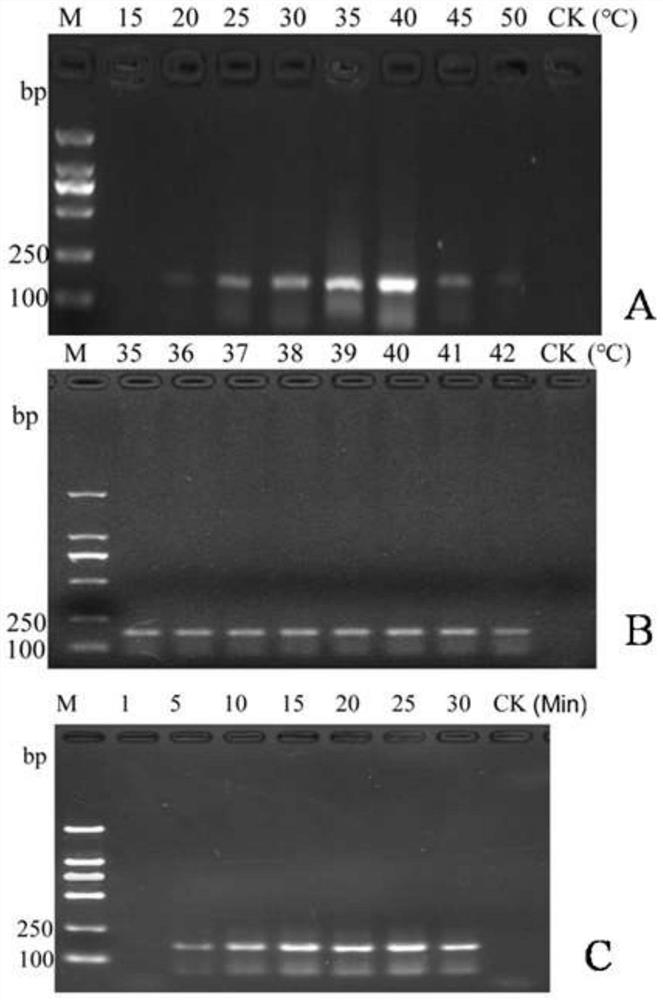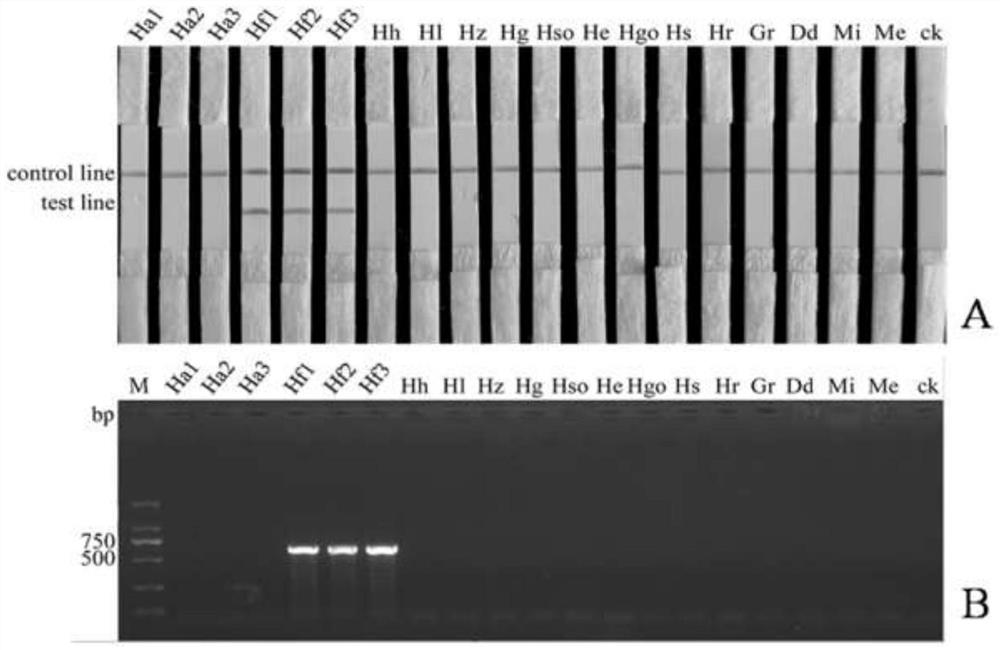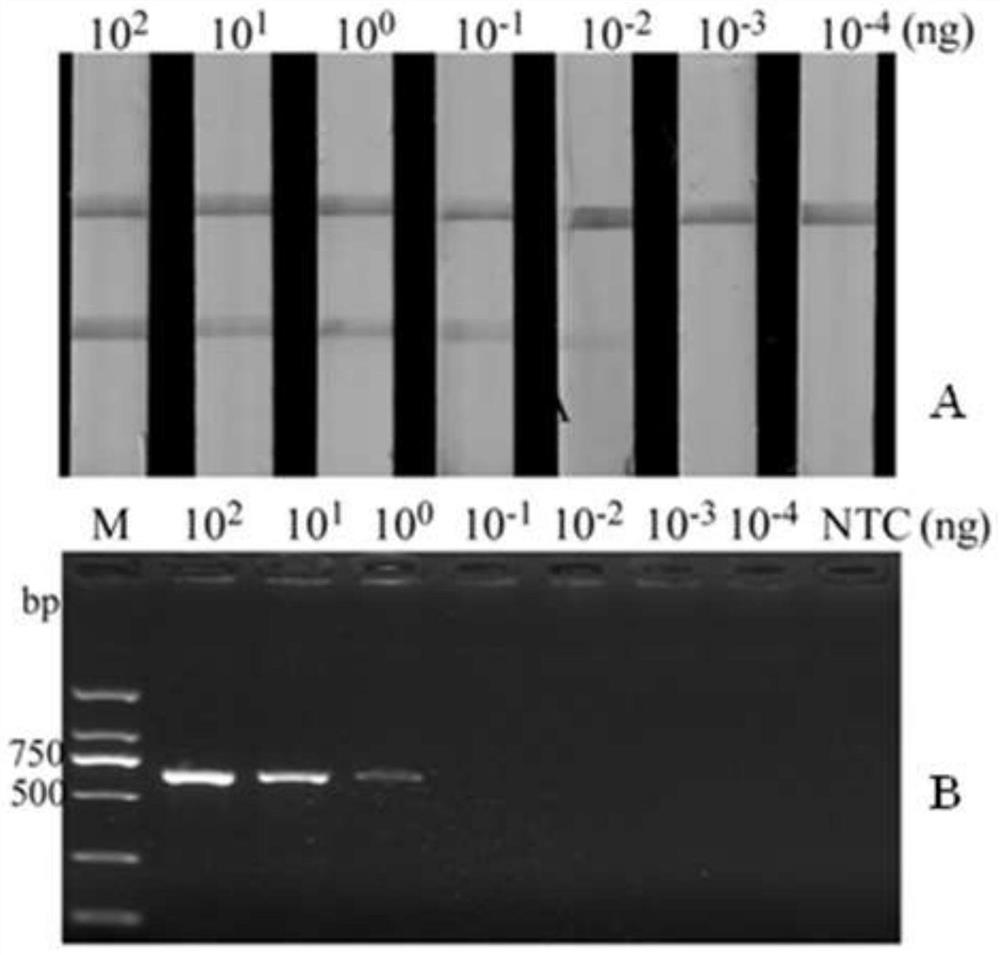RPA primer, probe and kit for rapidly detecting Heterodera filipjevi, and application of RPA primer and probe
A technology of Philips spore and cyst nematode, applied in the fields of biochemical equipment and methods, DNA/RNA fragment, recombinant DNA technology, etc., to achieve the effect of fast reaction speed, low equipment cost and high sensitivity
- Summary
- Abstract
- Description
- Claims
- Application Information
AI Technical Summary
Problems solved by technology
Method used
Image
Examples
Embodiment 1
[0042] The extraction of embodiment 1 Philip's cyst nematode DNA
[0043] Pick a single second-instar larva or cyst into a 0.2 mL PCR tube, add 20 μL DNA isolation buffer, including 10 μL double-distilled water (ddH 2 O), 7 μL PCR buffer [100 mM Tris-HCl (pH8.9), 500 mM KCl and 15 mM MgCl 2 ] (Takara-Bio, Shiga, Japan) and 3 μL Protein K [600ng / mL] (Solarbio, Beijing, China), DNA isolation methods such as Peng et al. (Peng H, Qi X, Peng D, et al. Sensitive and Direct Detection of Heterodera filipjevi in Soil and Wheat Roots by Species-Specific SCAR-PCRAssays.[J].Plant Disease, 2013,2(23):1-28). Pure genomic DNA was isolated from 5000 J2 using DNeasy Blood & Tissue Kit (Qiagen, Hilden, Germany) following the commercial instructions. According to the product instructions, use Soil DNA Isolation Kit (No.12988-10, Qiagen) was used to extract soil DNA (sDNA) from artificially inoculated soil and natural soil in the field. DNA was quantified using a Nano Drop ND-2000 spectrop...
Embodiment 2
[0044] Example 2 Establishment of RPA technology detection method for Philip's cyst nematode H.filipjevi
[0045] RPA primers and probes were designed according to the instructions of the DNA Constant Temperature Rapid Amplification Kit.
[0046] Primer design: A set of primers HfRPA-F3 and HfRPA-R3 were designed according to the SCAR-specific sequence (KC529338) of H. filipjevi, and the 5' end of the downstream primer was labeled with a modified gene (commonly used biotin). Fluorescent probe design: label the 5' end with a fluorescent group; in the middle of the upstream and downstream primers, design a 50bp complementary sequence to the target fragment. A tetrahydrofuran (THF) is marked in the middle of the 5' end and 3' end as the recognition site of nfo; the 3' end is marked with a modified gene (amine group, phosphate group or Spacer-C3 phosphoramidite).
[0047] Table 2 RPA primers and probes
[0048]
[0049] Using the specific primers and probes in Table 2, the H....
Embodiment 3
[0052] Example 3 Establishment and optimization of RPA-LFD system of Phillips cyst nematode.
[0053] On the basis of Example 2, 8 different reaction temperatures (15, 20, 25, 30, 35, 40, 45 and 50°C) and 7 reaction times (1, 5, 10, 15, 20, 25 and 30min). In order to further determine the optimal reaction temperature, a single second-instar larva of Phillips cyst nematode was used as a template, and the reaction was carried out at 8 different temperatures of 35, 36, 37, 38, 39, 40, 41 and 42°C. RPA amplification.
[0054] Such as figure 1 As shown, the results show that the RPA detection of Philip's cyst nematode can observe electrophoretic bands in the temperature range of 25 ° C to 45 ° C ( figure 1 A). Between 35°C and 42°C, the brightness of the bands did not increase significantly ( figure 1 B). In addition, seven RPA reactions were carried out at 40°C for different times, and the results showed that when the reaction time was 5 to 30 minutes, bands could be seen ( ...
PUM
 Login to View More
Login to View More Abstract
Description
Claims
Application Information
 Login to View More
Login to View More - R&D
- Intellectual Property
- Life Sciences
- Materials
- Tech Scout
- Unparalleled Data Quality
- Higher Quality Content
- 60% Fewer Hallucinations
Browse by: Latest US Patents, China's latest patents, Technical Efficacy Thesaurus, Application Domain, Technology Topic, Popular Technical Reports.
© 2025 PatSnap. All rights reserved.Legal|Privacy policy|Modern Slavery Act Transparency Statement|Sitemap|About US| Contact US: help@patsnap.com



